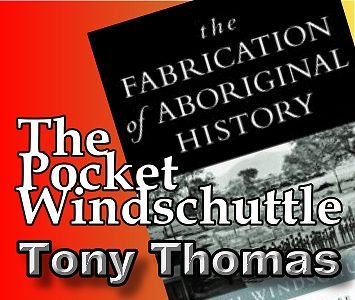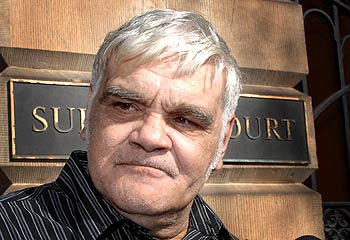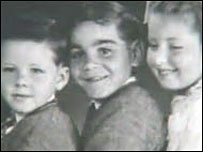The Pocket Windschuttle: The only successful “Stolen Generation” claimant
Tony Thomas: Although this is a pocket essay, I hope you have a big pocket. Some nitty-gritty about this landmark court case can’t be avoided. The case clarified that in SA, the law was against any ‘stealing’ of half-castes, and that the authorities cracked down when they discovered informal ‘adoptions’ had been taking place.
[Note: All page references are to The Fabrication of Aboriginal History – Volume Three: The Stolen Generations 1881-2008 by Keith Windschuttle (Macleay, 2009)]
Prime Minister Rudd apologized that there were “up to” 50,000 children stolen. Bringing Them Home thought it was up to 100,000. Many – a huge number – must still be alive. All have suffered legal wrongs.
Their plight has been known since 1981. There are lawyers by the hundred keen to work with them, and Aboriginal legal services would be eager to fund these cases. p571
But how many of them so far have won a full court case over their ‘stealing’? Just one, the late Bruce Trevorrow, who won $525,000 damages plus $250,000 interest in SA. p571 What an incentive for other genuine claimants to get redress! Windschuttle makes the obvious point: “On its own, the absence of any other successful court claim is enough to seriously question whether there ever were any Stolen Generations.” p572
Academic historians and lawyers have struggled to refute Windschuttle’s point, even claiming that the legal system which made land rights claims possible via the High Court’s Mabo and Wik judgements, must have been shrouded in racism when it happened to deal with Stolen Generations cases. p572
Windschuttle catalogues 19 significant court cases and reviews, mainly via the High Court, Federal Court and Supreme Court, involving Stolen Generations. Apart from Trevorrow’s Supreme Court case, there was one award of $35,000 ‘victim’s compensation’ in NSW, over a sexual assault after a woman was removed and placed with a family as a domestic.
In Victoria, there were some successful claims with $4000 awards each, under the state’s criminal injuries compensation scheme. Another case against the NSW government was settled out of court. In other words, these latter successes were all via compensation tribunals dealing with injuries after removal, not dealing with the removal as such. p573-575
Bruce Trevorrow, the successful claimant

Bruce Trevorrow, a part-aboriginal, in August 2007 in the SA Supreme Court before Justice Thomas Gray, was awarded $525,000 damages for having been separated from his parents when a baby, and for unlawful removal and false imprisonment. In February 2008 he won a further $250,000 in lieu of interest. p575
The Stolen Generations activists took this as vindication of their cause, and Lowitja O’Donoghue AO [but not ‘stolen’] wanted the Federal Government to scrap court hearings and just set up a compensation tribunal to hand out compensation to all ‘stolen’ children. p576
So what actually happened to Bruce Trevorrow?
On Christmas Day, 1957, a couple Mr and Mrs Evans, relatives but not Bruce’s parents Joseph and Thora, drove up to Adelaide Hospital with 13-month-old Bruce, and the hospital records put him as a ‘neglected child – without parents’. He suffered from ‘malnutrition’ and ‘infective diarrhoea’. The hospital notes said, “Mother {Thora} has cleared out and father {Joseph} is boozing. Apparently father is nourishing the children {Bruce and three siblings} with alcohol (could almoner please investigate).” p576
Joseph lacked a car and therefore had asked the Evans to do the hospital trip. The Evans provided the information the hospital recorded.
The Judge decided to reject the Evans’ view, in favor of the view of a local police sergeant, F.E. Liebing, and a local welfare officer, both of whom reported that Bruce was actually not neglected, that his father was not a drunkard and his mother had not abandoned him, merely decamped for a week after a domestic argument. p577
The Judge decided the family was poor but loving, and parenting was satisfactory. Moreover, the paediatrician who diagnosed Bruce on arrival as malnourished was wrong, the judge said, and other medicos who diagnosed merely gastro, dehydration and weight loss, were correct. Bruce’s treatment for gastro was successful and he was fit for release from hospital after 12 days. p578
However, things then went pear-shaped. A white couple from Adelaide, Martha and Frank Davies, had responded to an ad seeking foster parents for Aboriginal babies in the hospitals. The Aborigines Department advised them to see about Bruce. At the hospital they were told Bruce was neglected and abandoned, and they took him home on the same day, without paperwork. The arrangement was endorsed by a newly-appointed and inexperienced welfare officer for the Aborigines Department, Marjory Angas. Proper paperwork and licences for the transfer were done six weeks after the handover.
Angas apparently had been emotionally convinced of the need for the adoption. p579
Bruce’s true parents Thora and Joseph did not visit him in the 12 days Bruce was in hospital. Angas lied to them during the next six months about Bruce’s health and earlier transfer to white adopters.
The lying and obfuscating to Bruce’s mother continued over two years, to prevent her regaining custody of Bruce. It was not until Bruce was ten that he was finally re-united with his mother in the department’s offices in Adelaide. p580
Mrs Angas died well before the court case and was found to have been well-intentioned but prejudiced against the Trevorrow family, thinking their lifestyle was worse than it was. Angas had in fact become Bruce’s case officer for 20 years or so. p581
Bruce, despite the care of his adoptive parents, developed progressive health and psychiatric problems, on top of mild cerebral palsy and other conditions. By eight he was stealing from the family and showing other disorders. His foster mother herself needed hospitalization for psychological problems.  The adoption arrangement began breaking down. The department began making efforts to reunite Bruce with his mother Thora (whose de facto marriage to Joseph had since broken down). Officers took Bruce, now 10, to her at Victor Harbor twice for holidays, and then transferred him back to his mother Thora. p583
The adoption arrangement began breaking down. The department began making efforts to reunite Bruce with his mother Thora (whose de facto marriage to Joseph had since broken down). Officers took Bruce, now 10, to her at Victor Harbor twice for holidays, and then transferred him back to his mother Thora. p583
He didn’t adapt very well to his natural home either. Within a year he was arrested at Victor Harbor for housebreaking, and severely beaten by Thora. She then threw him out of her house. For the next ten years of his youth he was in reformatories, mental homes, and centres for disturbed youths, punctuated by brief spells back with his mother Thora and foster care with his grown-up Aboriginal siblings. At 13, he was also briefly fostered to another white mother. All these episodes ended the same way, with medical and behavioural disasters. p583
His law-breaking got worse and when he gained adult status, he was sentenced to 28 days prison but treated leniently and let off with a bond. He even got work as a prison officer-trainee and prison officer at Pentridge. p584
His adult life and relationships/marriages continued as dysfunctional, including domestic violence.
Justice Gray attributed the prime cause of Bruce’s sorry history to his enforced removal as a baby from his parents.
Windschuttle appears a little skeptical and comments that Bruce’s siblings, who were not separated from their parents, had their own share of social and behavioral problems. p585. Two half-brothers spent time in institutional care, one of them in prison. Two half-sisters also got involved with police and one was sent to a home for ‘wayward girls’. p586 Two siblings were never removed for any reason. p589
As for Bruce’s full siblings with Thora and Joseph, Thora five months after baby Bruce was first (and unlawfully) adopted out, left her three children with Joseph and went away with another man. Joseph in turn passed the two boys to his sister to look after, although the sister was both elderly and mentally disturbed. p586
The sister within a year sought to commit the boys to the Aborigines Board, but Joseph refused to consent and sent them back to Thora, whose current marriage was now ‘turbulent and violent’. Her husband bashed her so badly while he was drunk that he served time in prison for it. The two brothers then went back to Joseph.
Thora’s marriage and lifestyle kept deteriorating and her riverbank home was a damp and drafty shack with no toilet. She was ill and also had a new baby. Finally she left her husband and Marjory Angas, who long ago had ‘taken’ Bruce, arranged for her a house and welfare payments at Victor Harbor. Even so, in 1967 she was convicted of failing to send one of Bruce’s brothers to school and he was sent to a youth home for six months. p587
Windschuttle remarks that had Bruce not been ‘taken’, his life would have shared some of that subsequent mayhem, combined with his palsy and epilepsy. But none-the-less, his ‘adoption’ had been illegal and the judgement reflected this. Bruce received the payout. p588
On June 20, 2008, five months after the payment, Bruce died aged 51 of heart and lung problems. p588
Was Bruce Trevorrow one of the Stolen Generations?
The facts of the case above are analysed by Windschuttle against the ‘stolen generation’ thesis of permanent wholesale official removal of half-castes to destroy their Aboriginality.
He finds the exact opposite – the case disproves the thesis.
- Bruce’s half-caste siblings were not ‘taken’, even despite their torrid home background. One did spend six months in a ‘home’ as a result of truancy but like Bruce, was re-united with his mother by the same welfare officers who removed him.
- Welfare and police officers wrote separate and independent reports declining to remove the siblings on welfare (let alone ‘aboriginality’) grounds. They obviously hadn’t heard of the over-arching genocidal policies that latter-day historians insist was then prevailing. p590
- The judge noted that Aboriginal parents involved had the right to be consulted about removal of their children and the right to refuse such proposals. The father Joseph twice made such refusals. p590
- Once Bruce was removed, there was no attempt to turn him away from his Aboriginal heritage. He and others, via government policy, were officially encouraged to retain contact with their Aboriginal families. Official evidence was given in the case about how Aboriginal parents of children in institutions and foster care were encouraged to visit, and one officer said policy was to return them to their natural parents where possible, i.e. unless the home circumstances were too hazardous. p591
- The big issue in the Trevorrow case was that the actions of the Protection Board in ‘taking’ Bruce without his parents consent, were illegal at that time. The officials knew it. One of them said flatly that in his whole career as a welfare officer, he knew he had no power to remove Aboriginal children from their parents. p593
- As far back as 1949, the SA Crown Solicitor had affirmed that the Protection Board in SA could not legally remove children. Removal could only be authorized by the Children’s Welfare Department, which in turn had to convince a judge or magistrate that removal was in the child’s best interests. p593 “Stealing” of Aboriginal children had been made legally impossible since an Act of 1911. p594
Windschuttle suggests that Aboriginal welfare officers were at times so concerned at conditions under which children were living in shacks and camps, that they took some children illegally into institutions and foster homes. In October 1958 the Board’s secretary ‘confessed’ in a confidential note, that since about 1939 , some 300 such children had been removed. p600 Bruce would be one of them.
Others of the 300 may have been removed with their parents’ consent, but still illegally. A new Act in 1962 totally ended the SA Government’s paternalistic powers over Aborigines. p602
Windschuttle concludes that SA provides no support for the ‘stolen generation’ story, even allowing for the successful Trevorrow lawsuit. He concludes:
“One of the great ironies of the history of Aboriginal child welfare is that (South Australia) the state most reluctant to remove Aboriginal children from their parents turned out to be the only one that did so illegally.” p602
Read The Pocket Windschuttle by Tony Thomas here…
Buy The Fabrication of Aboriginal History – Volume Three: The Stolen Generations 1881-2008 here…
 Sign In
Sign In 0 Items (
0 Items ( Search
Search









Is it possible that Bruce Trevorrow has Foetal Alcohol Syndrome ? No, it wasn’t recognised back in 1957, but illnesses etc. don’t come into being merely because they have been given a name. It may have existed across Australia long before it was described and given a name and may have been involved in many cases of removal. Since everybody who was removed would hav e a file in their State Archives, a skilled nurse could recognise the symptoms of FAS in many cases ? All people have to do is find their files and present them to a court if they wish to be counted as part of a ‘stolen generation’. How many have done so ? One. Bruce Trevorrow.